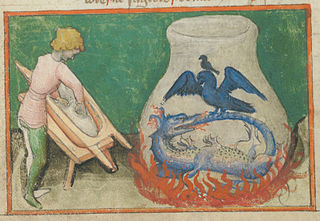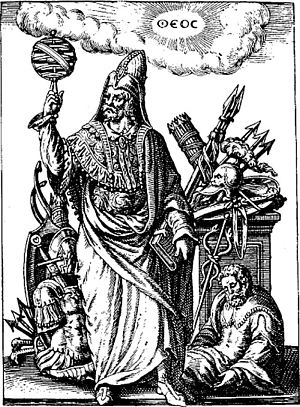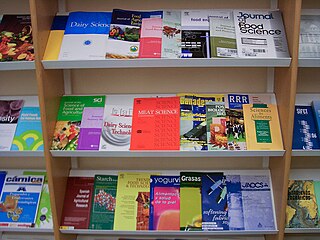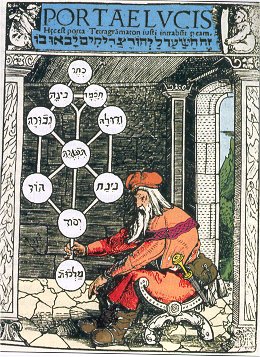
Alchemy is an ancient branch of natural philosophy, a philosophical and protoscientific tradition that was historically practiced in China, India, the Muslim world, and Europe. In its Western form, alchemy is first attested in a number of pseudepigraphical texts written in Greco-Roman Egypt during the first few centuries AD.

In academic publishing, a scientific journal is a periodical publication intended to further the progress of science, usually by sharing findings from research with readers. They are normally specialized based on discipline, with authors picking which one they send their manuscripts to.

Hermes Trismegistus is a legendary Hellenistic period figure that originated as a syncretic combination of the Greek god Hermes and the Egyptian god Thoth. He is the purported author of the Hermetica, a widely diverse series of ancient and medieval pseudepigraphica that lay the basis of various philosophical systems known as Hermeticism.

Robert Fludd, also known as Robertus de Fluctibus, was a prominent English Paracelsian physician with both scientific and occult interests. He is remembered as an astrologer, mathematician, cosmologist, Qabalist and Rosicrucian.

Hermeticism or Hermetism is a philosophical and religious system based on the purported teachings of Hermes Trismegistus. These teachings are contained in the various writings attributed to Hermes, which were produced over a period spanning many centuries and may be very different in content and scope.

The Ancient and Mystical Order Rosæ Crucis (AMORC), also known as the Rosicrucian Order, is the largest Rosicrucian organization in the world. It has various lodges, chapters and other affiliated bodies throughout the globe, operating in 19 different languages. It operates as a fraternal order in the mystical tradition, and supports secular research and learning in the arts and humanities.

Academic publishing is the subfield of publishing which distributes academic research and scholarship. Most academic work is published in academic journal articles, books or theses. The part of academic written output that is not formally published but merely printed up or posted on the Internet is often called "grey literature". Most scientific and scholarly journals, and many academic and scholarly books, though not all, are based on some form of peer review or editorial refereeing to qualify texts for publication. Peer review quality and selectivity standards vary greatly from journal to journal, publisher to publisher, and field to field.

An academic journal or scholarly journal is a periodical publication in which scholarship relating to a particular academic discipline is published. Academic journals serve as permanent and transparent forums for the presentation, scrutiny, and discussion of research. They nearly universally require peer review or other scrutiny from contemporaries competent and established in their respective fields. Content typically takes the form of articles presenting original research, review articles, or book reviews. The purpose of an academic journal, according to Henry Oldenburg, is to give researchers a venue to "impart their knowledge to one another, and contribute what they can to the Grand design of improving natural knowledge, and perfecting all Philosophical Arts, and Sciences."

Three Books of Occult Philosophy is Heinrich Cornelius Agrippa's study of occult philosophy, acknowledged as a significant contribution to the Renaissance philosophical discussion concerning the powers of magic, and its relationship with religion. The first book was printed in 1531 in Paris, Cologne, and Antwerp, while the full three volumes first appeared in Cologne in 1533.

Christian Rosenkreuz is the legendary, possibly allegorical, founder of the Rosicrucian Order. He is presented in three manifestos that were published early in the 17th century. These were:

Western esotericism, also known as esotericism, esoterism, and sometimes the Western mystery tradition, is a term scholars use to categorise a wide range of loosely related ideas and movements that developed within Western society. These ideas and currents are united since they are largely distinct both from orthodox Judeo-Christian religion and Enlightenment rationalism. It has influenced various forms of Western philosophy, mysticism, religion, pseudoscience, art, literature, and music.

Dame Frances Amelia Yates was an English historian of the Renaissance, who wrote books on esoteric history.

Manly Palmer Hall was a Canadian author, lecturer, astrologer, mystic and Freemason. Over his 70-year career he gave thousands of lectures and published over 150 volumes, of which the best known is The Secret Teachings of All Ages (1928). In 1934 he founded the Philosophical Research Society in Los Angeles.
Adam McLean is a Scottish writer on alchemical texts and symbolism. In 1978 he founded the Hermetic Journal which he published until 1992 during which time he also started publishing the Magnum Opus Hermetic Sourceworks, a series of 55 editions of key source texts of the hermetic tradition. From 2004 he began collecting tarot cards in order to document tarot art and built up a collection of 2500 items. In 2016 he set up the Surrealism Website in order to document surrealist painters. This currently shows the work of 100 surrealist artists. He also created a series of 20 video lectures on many facets of surrealist paintings. In 2017 he set up an art gallery The Studio and Gallery in Kilbirnie in North Ayrshire in order to promote the work of emergent and lesser-known artists.

The body of light, sometimes called the 'astral body' or the 'subtle body,' is a "quasi material" aspect of the human body, being neither solely physical nor solely spiritual, posited by a number of philosophers, and elaborated on according to various esoteric, occult, and mystical teachings. Other terms used for this body include body of glory, spirit-body, luciform body, augoeides, astroeides, and celestial body.
Mary Anne Atwood was an English writer on hermeticism and spiritual alchemy.

Hermetic Qabalah is a Western esoteric tradition involving mysticism and the occult. It is the underlying philosophy and framework for magical societies such as the Golden Dawn, Thelemic orders, mystical-religious societies such as the Builders of the Adytum and the Fellowship of the Rosy Cross, and is a precursor to the Neopagan, Wiccan and New Age movements. The Hermetic Qabalah is the basis for Qliphothic Qabala as studied by left-hand path orders, such as the Typhonian Order.

Renaissance magic was a resurgence in Hermeticism and Neo-Platonic varieties of the magical arts which arose along with Renaissance humanism in the 15th and 16th centuries CE. During the Renaissance period, magic and occult practices underwent significant changes that reflected shifts in cultural, intellectual, and religious perspectives. C. S. Lewis, in his work on English literature, highlighted the transformation in how magic was perceived and portrayed. In medieval stories, magic had a fantastical and fairy-like quality, while in the Renaissance, it became more complex and tied to the idea of hidden knowledge that could be explored through books and rituals. This change is evident in the works of authors like Spenser, Marlowe, Chapman, and Shakespeare, who treated magic as a serious and potentially dangerous pursuit.
Today in China, there are more than 8,000 academic journals, of which more than 4,600 can be considered scientific. About 1,400 cover health science. In 2022, it was reported that China has become one of the top countries in the world in both scientific research output, and also for highly cited academic papers.

Inquiry: Critical Thinking Across the Disciplines is a peer-reviewed academic journal established in 1988 by the Institute for Critical Thinking. The journal publishes articles and reviews on various aspects of critical thinking. After a brief suspension starting in 2005, publication of the journal resumed in 2010 with a new editorial team located at Sam Houston State University. The journal took another pause from 2016 to 2020, resuming publication in 2021. All issues are available online and single documents can be accessed by non-subscribers. The journal is published by the Philosophy Documentation Center. The founding editors-in-chief were Wendy Oxman and Robert Michael Esformes, the current editor is Thomas Brommage.














